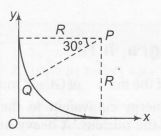A small block of mass 1 kg is released from rest at the top of a rough track. The track is a circular arc of a radius of 40 m. The block slides along the track without toppling and a frictional force acts on it in the direction opposite to the instantaneous velocity. The work done in overcoming the friction up to the point Q, as shown in the figure, is 150 J . (take the acceleration due to gravity, g=10 ms-2)

The speed of the block when it reaches the point Q is